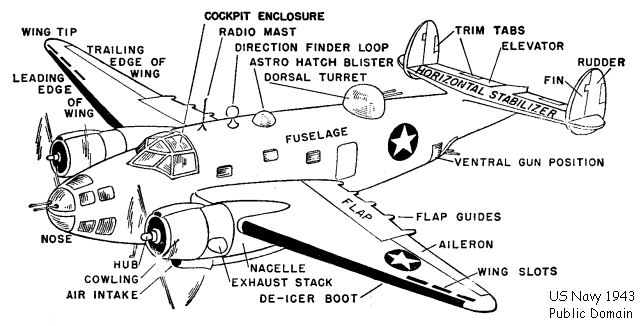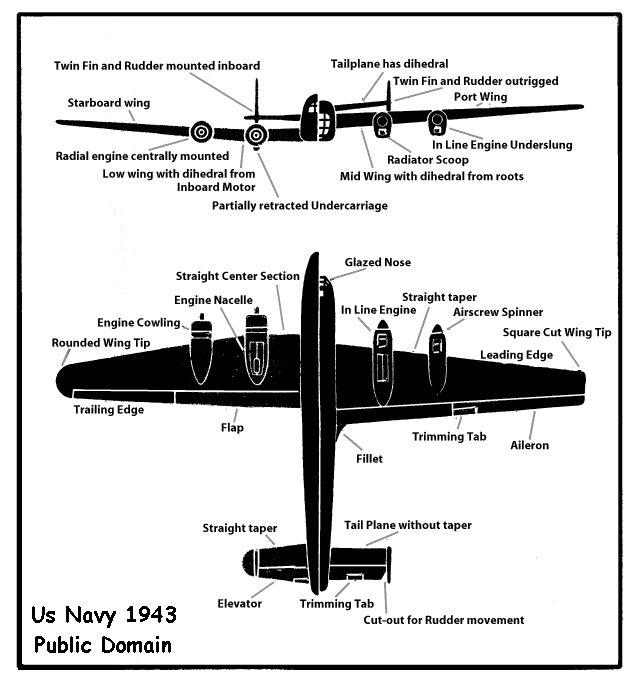about the aircraft that would appear in the Spontoon Island setting 1915 to 1945.

Spontoon Island
home
- contact - credits
- new - links -
history
- maps - art - story
comic
strips - editorial - souvenirs - Yahoo forum
First posted 23 July 2006

|
A
BEGINNER'S GUIDE TO AIRPLANES
Or AERONAUTICS FOR DUMMIES M Mitchell Marmel
Revised & update June 2005 (Illustrations
to be added by Ken Fletcher & others)
Since Spontoon is set in a scenario where seaplanes are important, it is a good idea to have an idea of just how airplanes work and what the major parts are called. HOW (LIGHTER THAN AIR) AIRSHIPS WORK Airships, including balloons, blimps and zeppelins (Figure 1), use a gas that is lighter than air (usually heated air in 'hot air' balloons, helium or hydrogen in blimps and zeppelins) Engines (if any) are discussed below. HOW (HEAVIER THAN AIR) AIRPLANES WORK Airplanes (Figure 2) fly because air flows past their wings, which are shaped into what is known as an 'airfoil' (Figure 3). The top of the wing is curved, while the bottom is flat. Since the air going over the wing has to arrive at the back of the airfoil at the same time the air going under the wing does, the top air goes faster. When air goes faster, it loses pressure. Since the air pressure under the wing is greater, 'lift' is created. In flight, various flight controls (see below) control the aircraft's movements along the yaw, pitch and roll axes (Figure 2a). SOME COMMON AERONAUTICAL TERMS: ENGINE: A self-contained device to produce power. A steam engine (Figure 4) uses external combustion of fuel to drive the workings, while a gasoline or Diesel engine (Figure 5) uses internal combustion to drive the workings. MOTOR: A device that uses external power to work, such as an electric motor (Figure 6). PROPELLER: The airscrew on the front (Figure 7) or rear (Figure 8) of the aircraft, which is connected to the engine and provides forward thrust. PUSHER/TRACTOR: Indicates whether the propeller is pushing or pulling the plane through the air. Most conventional aircraft use a tractor arrangement, while planes such as the Lake Amphibian are pusher aircraft. FUSELAGE: Enclosed area, which may contain the engine, pilot's compartment or cockpit, passenger compartment, etc. (Figure 9), depending on configuration. EMPENNAGE: Fancy term for the tail section (Figure 9a). LANDING GEAR: What the aircraft uses for landing. This can be wheels (Figure 9b), skis or skids (Figure 9c), or flotation devices (Figure 9d). SEAPLANES: Airplanes designed or equipped for water landing. These can be floatplanes (Figure 10) which are like land-based planes equipped with floats, or flying boats (Figure 10a) which use the fuselage as a sea-going structure. AUTOGYRO: A helicopter precursor, using a rotating blade instead of a fixed wing to generate lift. (Figure 11) MORE ADVANCED AERONAUTICAL TERMS: Engine ROTARY ENGINE: An engine with cylinders that rotate around a fixed crankshaft. Reliable and simple, but problems with the gyroscopic effects of hundreds of pounds of whirling metal on the front of an aircraft rendered them obsolete quickly. (Figure 12a) RADIAL ENGINE: Similar in appearance to a rotary engine, but the cylinders remain stationary while the crankshaft rotates and drives the propeller. Most radial engines have an odd number of cylinders (3,5,7,9). Because they are relatively flat (front-to-back), 14 and 18 cylinder engines can be easily constructed by having more than one row (or bank) of cylinders. (Figure 12b) INLINE ENGINE: An engine with all the cylinders in a straight line. (Figure 12c) OPPOSED (BOXER) ENGINE: An engine with opposed cylinders, such as is found in the Piper Cub. (Figure 12d) V-TYPE ENGINE: Engine with two straight-line banks of cylinders in a 'v' arrangement, such as a V-8 engine (Figure 12e). (Commentary by Steve Gallacci: Advantages of radials were that they have somewhat better power/wieght ratio and as most are air-cooled, don't have the complication of a separate cooling system. In-line, V, W, X and H geometry engines almost always are liquid-cooled (needs a radiator). At the same time, the radial has the disadvantage of being round and wide and needing an air inlet for cooling, while the various in-line types were mostly long and narrow, allowing for a more streamlined shape.) SUPER/TURBOCHARGER: A device for piston engines. Increases the air pressure within the intake manifold, allowing for improved operation at lower altitudes and higher upper operational altitudes. A supercharger is mechanically driven by the engine, while a turbocharger uses engine exhaust to operate. INTERRUPTER GEAR: A synchronizer gear used in fighter aircraft having guns that fire through the propeller. The interrupter gear prevents the gun from firing when the propeller blade is blocking the muzzle. TURBINE ENGINE: An engine using a jet effect instead of cylinders to develop thrust (Figure 13). A turbine differs from a jet engine in that a turbine at the back of the engine turns a compressor rotor in the front of the engine, drawing air into the combustion chamber to be burned and then blown out the back, driving the turbine. TURBOJET: A turbine engine using the jet effect as sole propulsion. (Figure 13a) TURBOFAN: A turbine engine using the rotation of the turbine shaft to drive a large enclosed fan with numerous blades at the front of the engine for additional thrust. This is the drive of choice for modern jet airliners. (Figure 13b) TURBOPROP: A turbine engine that drives a conventional propeller. (Figure 13c) Flight Controls: AILERON: Movable surfaces on the wing that control roll (Figure 14a) ELEVATOR: Movable surface on the horizontal stabilizer that controls pitch (Figure 14b) RUDDER: Movable surface on the vertical stabilizer that controls yaw (Figure 14c) ADVANCED CONTROLS: More exotic aircraft may have combination controls, such as stabilators, ruddervators or ailevators. These follow function pretty much as their names describe, and require advanced mechanical/hydraulic systems to operate properly (Figure 15). Airframe: FRAME CONSTRUCTION: Generally wooden or metal tube frame, with cloth stretched over the frame for covering. Simple and light, but limited in top speed. (Figure 16a). MONOCOQUE CONSTRUCTION: Usually all metal, possibly with cloth panels or plywood covering on the wings. The outer skin becomes part of the structure. Most modern aircraft (from 1930 on) are of this type. (Figure 16b). LONGERON: A longitudinal brace within the fuselage. FAIRING: A sheet metal shape placed over a protruding object (engine cylinders, landing gear, et cetera) to cut down on wind resistance. (Figure 16c). PONTOON: Another word for 'float'. SPONSON: In flying boats, small stub wings located near the waterline to aid stability. (Figure 17a). OUTRIGGERS: Small pontoons mounted on the wings to keep them from dipping in the water. Usually found in flying boats and single-float planes. (Figure 17b). COCKPIT: (aka 'the front office') Aircraft cockpits can range from spartan to a bewildering display of controls and instruments. Here's a selection of the basics: JOYSTICK/YOKE: Controls the ailerons and elevator (roll and pitch). As a general rule, smaller aircraft and types requiring quick maneuverabilty (i.e. fighters) will have joysticks, whereas more sedate transports and the like will have yokes or even steering wheels. RUDDER PEDALS: Controls the rudder. Brake pedals (if any) are also usually incorporated. THROTTLE: Controls engine speed. PROP PITCH: If the propeller pitch can be controlled, this is the control for it. MIXTURE CONTROL: Since an aircraft travels at a great variety of altitudes, the pilot is required to lean (decrease) or richen (increase) the ratio of gasoline to air going into the engine accordingly. The mixture control accomplishes this. CARBURETOR HEAT: Diverts some heat from the exhaust to the carburetor to prevent icing, particularly when descending. Used in all climates, even hot ones. FLAP CONTROL: Later, more advanced aircraft models have 'flaps' on their wings to improve landing characteristics and shorten the landing roll. This control activates them. Instruments: AIRSPEED: Shows the speed of the aircraft relative to the surrounding air. If ambient wind conditions are known, actual ground speed can be computed. TURN AND BANK: Also known as the 'needle and ball'. A gyroscopic device to indicate if you are turning. The needle indicates whether the wings are level and the ball in a shallow U shaped tube indicates whether the turn is balanced properly. ARTIFICIAL HORIZON: Usually found in more sophisticated aircraft. Also gyro driven, this sets up a 'horizon' consisting of a flat line across the face, sometimes with a color-coded sky section. Used for instrument flight. TACHOMETER: Indicates engine speed in revolutions per minute. OIL PRESSURE: Indicates engine oil pressure. Low oil pressure is an indicator of engine trouble. EXHAUST TEMPERATURE: Indicates how the fuel ratio is doing. A leaner mixture results in higher exhaust temperatures. MANIFOLD PRESSURE: With variable pitch props and turbochargers, attention must be paid to intake manifold pressure so that overly high and low pressures are not reached. Also useful for synchronizing engines in multi-engine aircraft. |

